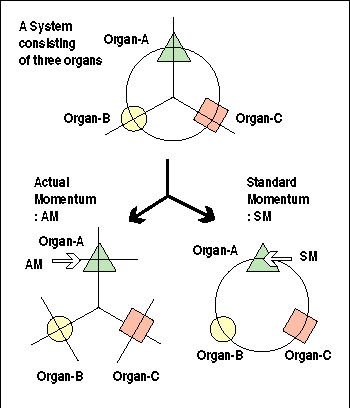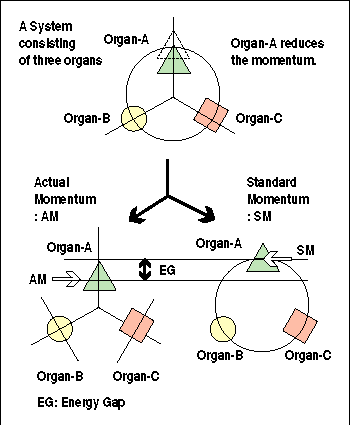|
2. Actual Momentum and Standard Momentum
An organ has two kinds of momenta, which are "Actual Momentum" and "Standard Momentum." Importantly, a tissue causes an energy gap on the basis of the relative difference in momentum between the actual and the standard momentum. Thus, understanding these two kinds of momenta is indeed essential for us to understand the concept of "Energy Gap."
"Actual Momentum" of an organ indicates the momentum an organ actually contains. For example, when an organ raises the momentum, it also raises the actual momentum. In contrast, when an organ reduces the momentum, it also reduces the actual momentum. That is, actual momentum of an organ is just the same as the momentum the organ contains.
"Standard Momentum" of an organ indicates the momentum controlled by background organs of the organ. For example, as shown in the figure below, imagine a system consisting of three organs: organ-A, organ-B, and organ-C. In this system, organ-A always balances itself with the background organs: organ-B and organ-C, because the system has its own stability on the basis of the balance among the three organs. Thus, this system can control the momentum contained in organ-A by using organ-B and C. Just this momentum indicates "Standard Momentum" of organ-A.

Importantly, using the two kinds of momenta allows us to explain easily how an organ causes "Energy Gap." In the figures below, when organ-A, for instance, changes the momentum, it also changes the actual momentum. However, the background organs of organ-A (organ-B and C) do not change their momenta, so that organ-A does not change the standard momentum. As a result, by the relative difference in momentum between the actual momentum and the standard momentum, organ-A causes "Energy Gap." As seen in this process, the relationship between "Actual and Standard Momentum" directly controls "Energy Gap."

|